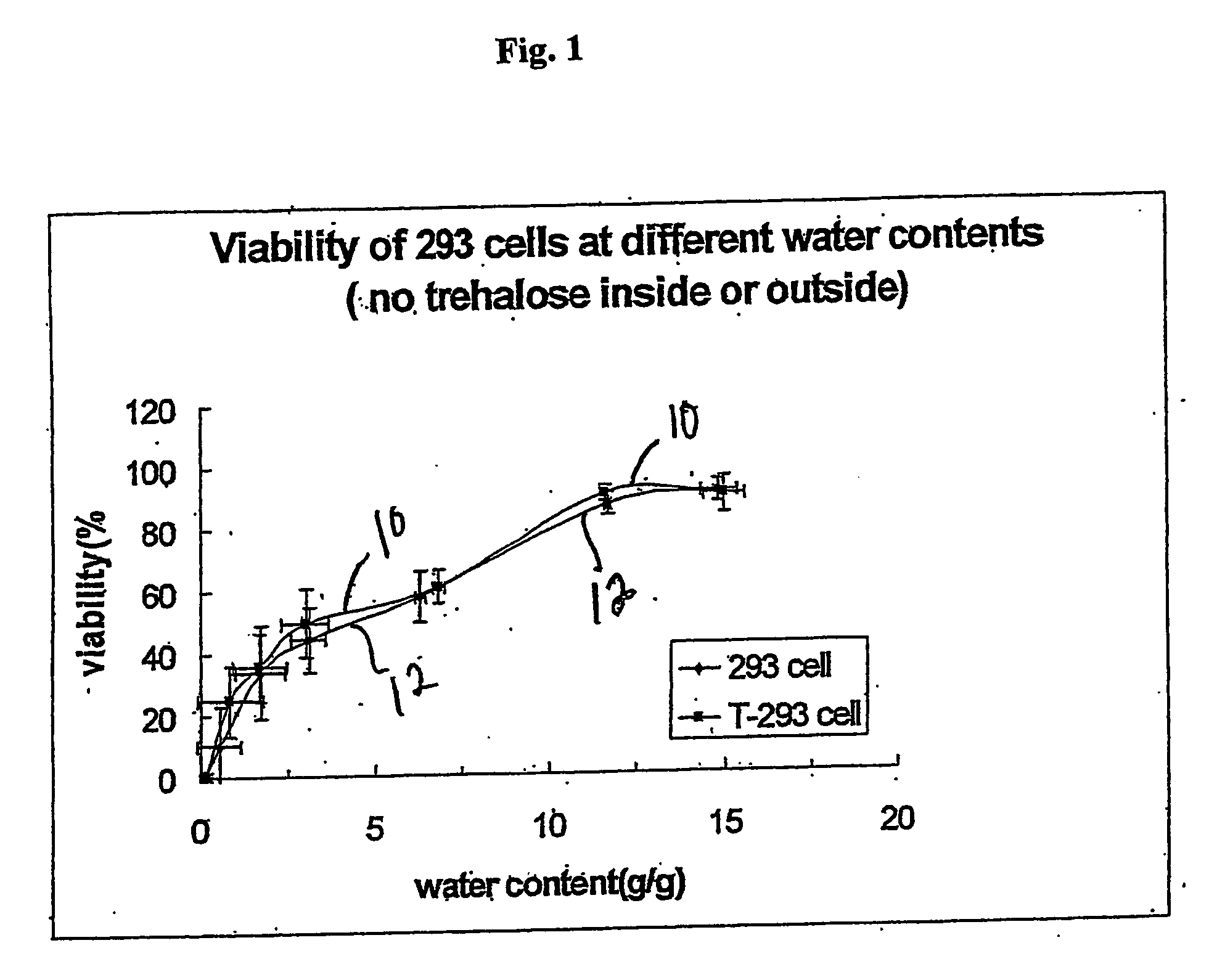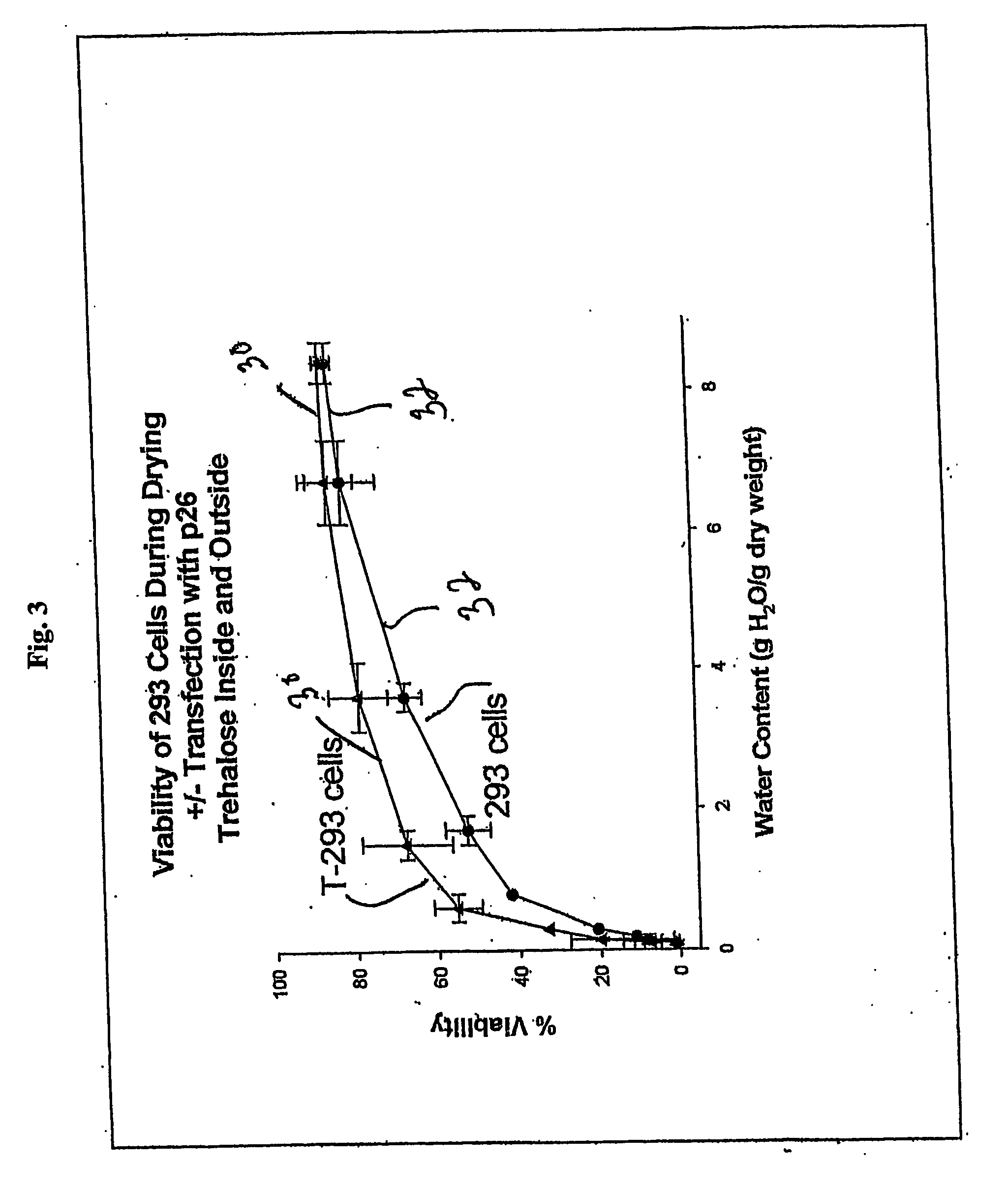Methods for preserving nucleated mammalian cells
a nucleated mammalian cell and cell technology, applied in the field of biological samples, can solve the problems of inability to carry and store mammalian cells for in vitro and in vivo use, inability to maintain the integrity of the cell, and inability to fully recover, so as to improve the viability and activity of mammalian nucleated cells
- Summary
- Abstract
- Description
- Claims
- Application Information
AI Technical Summary
Benefits of technology
Problems solved by technology
Method used
Image
Examples
example i
[0143] p26 was purified from encysted embryos of A franciscana (San Francisco Bay) purchased from San Francisco Bay Brand, Newark, Calif., USA. Purification steps were performed at 4° C. or on ice. Dried embryos (50 g), were hydrated at 4° C. for 16 hours in sea water; filtered; washed with cold 40 mM HEPES-KOH, pH 7.5, at 4° C., 70 mM NaCl, and 1 mM EDTA (buffer A); and homogenized in the same buffer with a Retsch motorized mortar and pestle (Brinkman Instruments, Canada). The homogenate was centrifuged (4000×g, 20 minutes) and the supernatant filtered through 6 layers of cheesecloth, centrifuged again at 16 000×g for 40 minutes, and then at 23 500×g for 30 minutes. Solid (NH4)2SO4 was added to 40% saturation in the final supernatant. Precipitated proteins were collected at 10 000×g for 30 minutes; dissolved in 20 mM Tris-HCl, pH 8.15, 150 mM NaCl, 1 mM MgCl2, and 0.1 mM EDTA (buffer B); and dialyzed overnight against this buffer. After dialysis, the solution was passed through a 0...
example ii
[0144] 293 cells and T293 cells were grown in T-25 flasks to ˜90% confluence. The cells were harvested by trypsinization according to standard protocols. Briefly, the medium was removed from the cultures and they were washed one time with 5 mL DPBS. Trypsin (1 mL of 0.05% in 0.53 mM EDTA-4Na) was added to the culture for ˜1 min and the flasks were rapped to dislodge the cells. Medium (4 mL) was added to stop the reaction, and the cells were pelleted by centrifugation at 176×g for 5 min. The pellet was suspended in 5-10 mL DPBS and the centrifugation step was repeated. The cell pellet was then suspended in air drying buffer lacking trehalose (10 mM Hepes, 5 mM KCl, 65 mM NaCl, and 5.7% BSA with pH 7.2) at 1.4 million cells per mL. Aliquots (1.0 mL) were placed in 35 mm polysterene Petri dishes and air-dried in a ThermoForma biosafety cabinet in specific marked locations in the center of the hood over 0-24 hours. At various time points during drying, samples were removed for viability...
example iii
[0145] 293 cells and T293 cells were grown in T-25 flasks to ˜90% confluence. The cells were harvested by trypsinization according to standard protocols. Briefly, the medium was removed from the cultures and they were washed one time with 5 mL DPBS. Trypsin (1 mL of 0.05% in 0.53 mM EDTA-4Na) was added to the culture for ˜1 min and the flasks were rapped to dislodge the cells. Medium (4 mL) was added to stop the reaction, and the cells were pelleted by centrifugation at 176×g for 5 min. The pellet was suspended in 5-10 mL DPBS and the centrifugation step was repeated. The cell pellet was then suspended in air drying buffer containing trehalose (10 mM Hepes, 5 mM KCl, 65 mM NaCl, 150 mM Trehalose, and 5.7% BSA with pH 7.2) at 1.4 million cells per mL. Aliquots (1.0 mL) were placed in 35 mm polysterene Petri dishes and air-dried in a ThermoForma biosafety cabinet in specific marked locations in the center of the hood over 0-24 hours. At various time points during drying, samples were ...
PUM
| Property | Measurement | Unit |
|---|---|---|
| Temperature | aaaaa | aaaaa |
| Temperature | aaaaa | aaaaa |
| Fraction | aaaaa | aaaaa |
Abstract
Description
Claims
Application Information
 Login to View More
Login to View More - R&D
- Intellectual Property
- Life Sciences
- Materials
- Tech Scout
- Unparalleled Data Quality
- Higher Quality Content
- 60% Fewer Hallucinations
Browse by: Latest US Patents, China's latest patents, Technical Efficacy Thesaurus, Application Domain, Technology Topic, Popular Technical Reports.
© 2025 PatSnap. All rights reserved.Legal|Privacy policy|Modern Slavery Act Transparency Statement|Sitemap|About US| Contact US: help@patsnap.com



